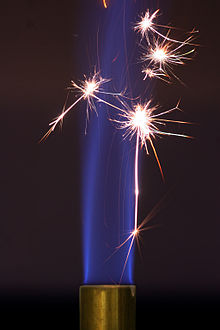
Back توهج Arabic Incandescència Catalan Inkandescence Czech Glut (Lichtausstrahlung) German Πυράκτωση Greek Incandescencia Spanish Goritasun Basque فروزندگی Persian Incandescence French Gealbhruthaíl Irish


Incandescence is the emission of electromagnetic radiation (including visible light) from a hot body as a result of its high temperature.[1] The term derives from the Latin verb incandescere, to glow white.[2] A common use of incandescence is the incandescent light bulb, now being phased out.
Incandescence is due to thermal radiation. It usually refers specifically to visible light, while thermal radiation refers also to infrared or any other electromagnetic radiation.
- ^ Dionysius Lardner (1833). Treatise on Heat. Longman, Rees, Orme, Brown, Green & Longman. p. 341.
The state in which a heated body, naturally incapable of emitting light, becomes luminous, is called a state of incandescence.
- ^ John E. Bowman (1856). An Introduction to Practical Chemistry, Including Analysis (Second American ed.). Philadelphia: Blanchard and Lea. p. 283.
incandesce 0-1860.
© MMXXIII Rich X Search. We shall prevail. All rights reserved. Rich X Search